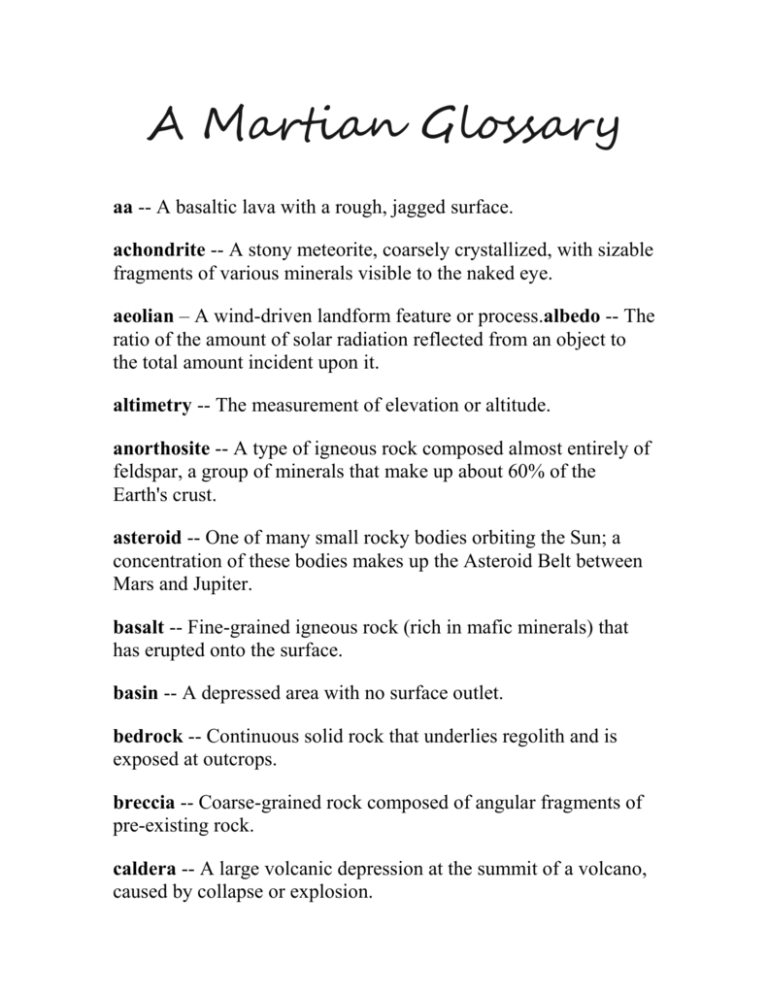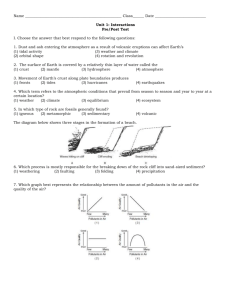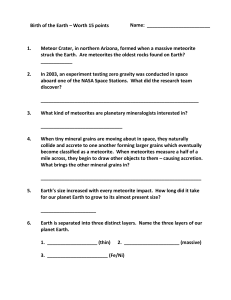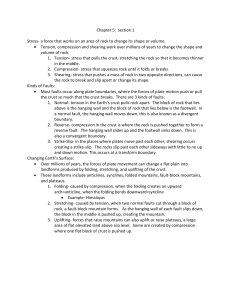A Martian Glossary
advertisement

A Martian Glossary aa -- A basaltic lava with a rough, jagged surface. achondrite -- A stony meteorite, coarsely crystallized, with sizable fragments of various minerals visible to the naked eye. aeolian – A wind-driven landform feature or process.albedo -- The ratio of the amount of solar radiation reflected from an object to the total amount incident upon it. altimetry -- The measurement of elevation or altitude. anorthosite -- A type of igneous rock composed almost entirely of feldspar, a group of minerals that make up about 60% of the Earth's crust. asteroid -- One of many small rocky bodies orbiting the Sun; a concentration of these bodies makes up the Asteroid Belt between Mars and Jupiter. basalt -- Fine-grained igneous rock (rich in mafic minerals) that has erupted onto the surface. basin -- A depressed area with no surface outlet. bedrock -- Continuous solid rock that underlies regolith and is exposed at outcrops. breccia -- Coarse-grained rock composed of angular fragments of pre-existing rock. caldera -- A large volcanic depression at the summit of a volcano, caused by collapse or explosion. chasma -- A large canyon. chondrite -- A stony meteorite, composed of finely crystallized material. coma -- A roughly spherical region of diffuse gas which surrounds the nucleus of a comet. Together, the coma and the nucleus form the comet's head. comet -- A small celestial body composed at least partially of ices. Comets either orbit the Sun or pass through the Solar System on hyperbolic orbital paths . corona -- A circular to elongate feature which is surrounded by multiple concentric ridges. Coronae are thought to be formed by hot spots. crater -- An approximately circular depression, sometimes surrounded by a raised rim. Craters are typically formed by explosion during meteorite impact. crust -- The outermost layer of the lithosphere. cuspate -- Shaped like a cusp; a sharp projection of material. drift -- A general term for all rock debris transported from one place and deposited in another, and distinguished from solid bedrock. ejecta -- Material thrown out of a volcano or impact crater. escarpment -- A long, more or less continuous cliff or relatively steep slope facing in one general direction, produced by erosion or faulting. fault -- A fracture or zone of fractures in a planet's crust, accompanied by displacement of the opposing sides. geomorphology -- The study of the external structure, form, and arrangement of rocks in relation to the development of landforms. geyser -- A type of hot spring that intermittently erupts jets of material graben -- A long, relatively depressed crustal unit or block that is bounded by faults along its sides; a trough. Hubble -- Edwin Powell Hubble (1889-1953) American astronomer known for seminal work in modern cosmology. hummocky -- Uneven; describing a terrain abounding in irregular knolls, mounds, or other small elevations. igneous rock -- Rock solidified from a molten state. Imbrium -- Mare Imbrium - Latin for "Sea of Rains". Kuiper -- Gerard Peter Kuiper (1905-1973) American astronomer born in The Netherlands. Studied the origin of the solar system, and planetary atmospheres. limb -- The outer edge of a lunar or planetary disk. lineament -- A linear topographic feature, such as a fault line, aligned volcanoes, or straight stream course. magnetosphere -- a region of a planet's atmosphere that is dominated by the planet's magnetic field so that charged particles are trapped in it. mantle -- The main bulk of a planet between the crust and the core; on Earth, the mantle ranges from about 40 to 2,900 kilometers (25 to 1800 miles) below the surface. mare -- A dark, low-lying lunar plain, filled to some depth with volcanic rocks. Mars -- Planet fourth in order from the sun. In Roman mythology, god of war and discord (Greek name, Ares). massif -- A massive topographical feature, commonly formed of rocks more rigid than those of its surroundings. meteorite -- A stony or metallic object from interplanetary space that impacts a planetary surface. nucleus -- The frozen core of a comet which contains almost the entire cometary mass and is located in the comet's head. Olympus -- In Greek mythology, the mountain that is home to the gods. Orientale -- Latin for "Eastern". pahoehoe -- A basaltic lava with a smooth, undulating surface. perihelion -- The point in the path of a planet, asteroid, comet, or other body that is closest to the sun. Proteus -- In Greek mythology, the son of Poseidon. Personification of the shifting winds and moods of the sea. Phobos -- In Greek mythology, a son of Ares (Mars) who, with brother Deimos, was a constant companion to his father. plateau -- Any comparatively flat area of great extent or elevation. plume -- A buoyant mass of hot, partially molten mantle material that rises to the base of the lithosphere. Pluto -- Planet ninth in order, and farthest, from the sun. In Greek mythology, god of the dead and the underworld. regolith -- Any solid material lying on top of bedrock, including soil and rock fragments. relief -- The maximum regional difference in elevation. rift -- A valley formed at a divergence zone or other area of extension. rille -- One of several trenchlike, or cracklike valleys up to several hundred km long and 1-2 km wide commonly occurring on the Moon's surface. scarp -- A cliff or steep slope of some extent that may form a marked topographic boundary. shield volcano -- A broad volcanic cone with gentle slopes constructed of successive nonviscous, mostly basaltic, lava flows slumping -- A landslide that results from the downward sliding of rock debris as a single mass, usually with a backward rotation relative to the slope along which the movement takes place. tectonic -- Relating to the deformation of the crust of a moon or planet, the forces involved in or producing such deformation, and the resulting forms. tectonics -- Structural deformation, especially folding and faulting. terminator -- The line separating the illuminated and unilluminated parts of a celestial body; the dividing line between day and night as observed from a distance. terrestrial -- Belonging to the class of planets that are similar to the Earth in density and composition (i.e. Mercury, Venus, and Mars). Tethys -- In Greek mythology, a sea goddess. topography -- The shape and form of the surface of a planet. trough -- A long linear depression vent -- An opening or fissure in a planet's surface through which volcanic material erupts. viscosity -- A measure of resistance to flow. volcanic rock -- Rock formed by eruption onto a planet's surface.










